In Canada, adaptation scientists emphasize how challenging decision-making is (Boyd and Markandya, 2021). More specifically, the main challenges involve bringing together an economic appraisal for a diversity of risks emerging from climate change, in order to estimate the costs of inaction, but also the costs of adaptation solutions as well as their effectiveness and impacts, such as opportunity costs or exacerbation of inequalities, and uncertainties.
That said, the very notion of climate risk is evolving. It is now based on the intersection of four main axes: hazards / direct physical impacts; exposure; vulnerability (sensitivity, adaptive capacity); and response (IPCC, 2022; see Figure 1). Decision-making needs to be based on this definition for both slow-onset risks (climatic stresses) and rapid-onset risks (climatic shocks) and for both current and future climate contexts.
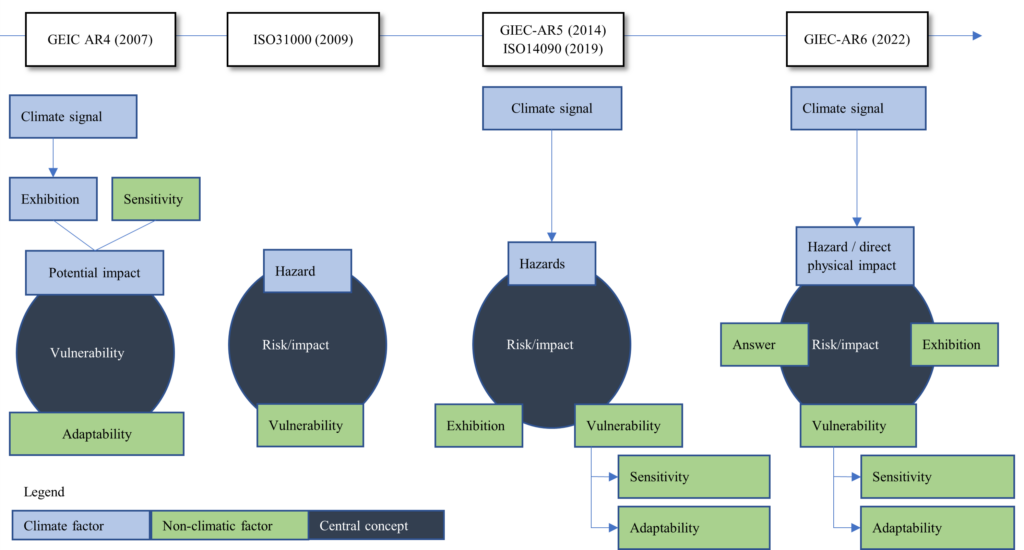
Source: Original figure, inspired by GIZ and EURAC (2017), IPCC (2022). The notion of climate risk is evolving both theoretically and operationally. Starting in the 2000s with a vulnerability-centric conception from the IPCC (2007) and centred on a two-axis risk (vulnerability and hazards) in risk management (ISO31000), the publication of the most recent IPCC report (2022) now defines risk at the intersection of four main axes: hazards / direct physical impacts; exposure; vulnerability (sensitivity, adaptive capacity); and response. However, current operational practices (e.g. ISO14090) are still based on the intermediate 3-axis version of risk (hazards, exposure, vulnerability) (IPCC, 2014).
Moreover, as collective concern for environmental and social issues has evolved, the evidence-based practices of economic analysis have adapted to support efficient collective decisions, as illustrated by the most recent cost-benefit analysis (CBA) guides (e.g. OECD, 2018; see box text below).
This approach to long-term efficiency is within the reach of organizations, but does it hold up in the context of climate change adaptation in Quebec? This article illustrates best practices for adapting CBA to the context of climate change, by analyzing a case study carried out in Quebec in 2016 on coastal risks in Percé, on the Gaspé Peninsula (Circé et al., 2016), in order to highlight the benefits of this approach, as well as lessons, recommendations, and avenues for research.
What is cost-benefit analysis in the context of climate change adaptation?
Cost-benefit analysis (CBA) compares the sum of the net benefits of each adaptation option from society’s point of view. It is a method that has been widely used by various levels of government for several decades. Over a given period, it can be used to estimate the economic value of a project’s impacts on its economic, environmental, and social components. CBA makes it possible to compare different adaptation options over time on a common basis through the use of indicators (net present value [NPV]; benefit-cost ratio [BCR]), and thus to classify the options studied according to their economic performance.
A CBA differs from a financial analysis in that it considers an option’s direct and indirect economic, environmental, and social benefits and costs, whereas a financial analysis is concerned only with cash flows for the promoter and does not take into account the externalities associated with carrying out a project, such as its social and environmental impacts.
Carrying out a CBA includes six main steps: 1) identification of adaptation options; 2) identification of the perceived impacts of adaptation options and non-intervention; 3) monetization of negative impacts (costs) and positive impacts (benefits); 4) estimation of the costs of implementing adaptation options; 5) comparison of costs and benefits; 6) sensitivity analysis of results (Adapted and translated from Circé et al. 2016).
In the context of climate change adaptation, solutions designated as « optimal » following a CBA are those that minimize costs (design, implementation, maintenance, impact on vulnerable groups, etc.), increase benefits (averted costs for risky activities; ecosystem enhancement including the social cost of carbon; enhancement of regional economic drivers, health, and quality of life), offer flexibility and adaptability in the future, while remaining robust (see diagram below).
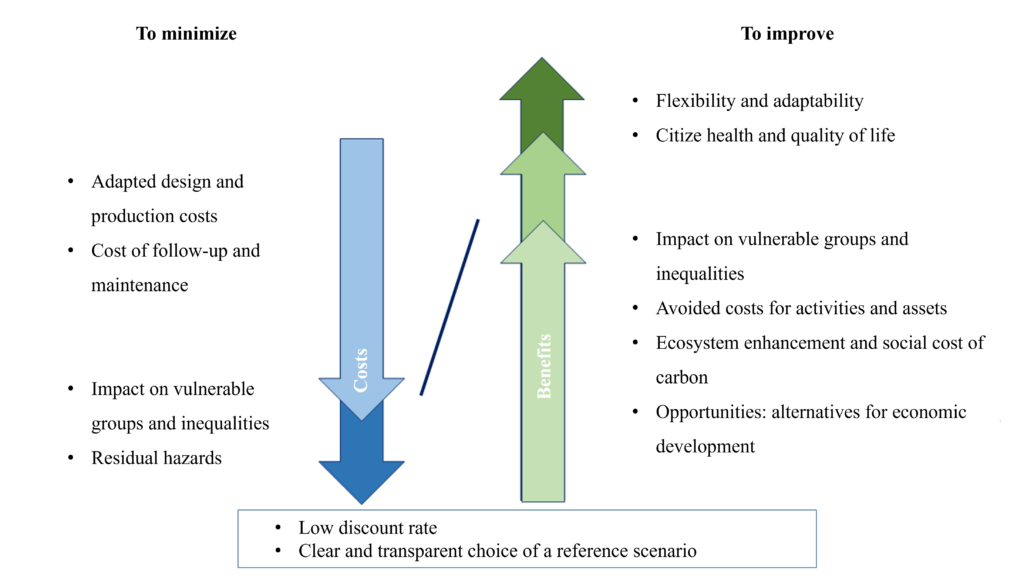
Considering Costs and Benefits: The Case of Percé’s Boardwalk in the Face of Bank Erosion
Informed Collective Choice: Risk-based CBA for Climate Change
Percé’s iconic promenade provides a privileged view of the spectacular Percé Rock and attracts around 4,000 tourists annually (Circé et al., 2016). However, coastal hazards—mainly bank erosion—have damaged the boardwalk, which dates back to the 1960s, with an anticipated erosion rate of 9–15 cm/year, jeopardizing infrastructure. Faced with this situation, the municipality and the provincial and federal governments joined forces to make an informed decision about whether or not to jointly invest in repairing the boardwalk. And, if so, which option would be most advantageous in the long term. The following options were considered:
- Non-intervention
- Rebuilding a boardwalk that can withstand future conditions
- Pebble beach nourishment
- Pebble beach nourishment with groynes (structures perpendicular to the shoreline to attenuate wave energy)

To make this informed collective choice, a CBA was carried out, comparing several adaptation options. However, certain key points were modified to account for climate change:
- Extending the timeframe for decisions
- Integrating climate risks
- Choosing solutions to take greater complexity into account
The modifications and improvements made to the CBA for the Percé case are summarized in Table 1. To reflect the state of the art since 2016, additions have been made (CBA Guide, OECD, 2018, and Guide ACA Inondations, Boyer-Villemaire et al., 2021). The glossary below lists and defines the technical terms used.

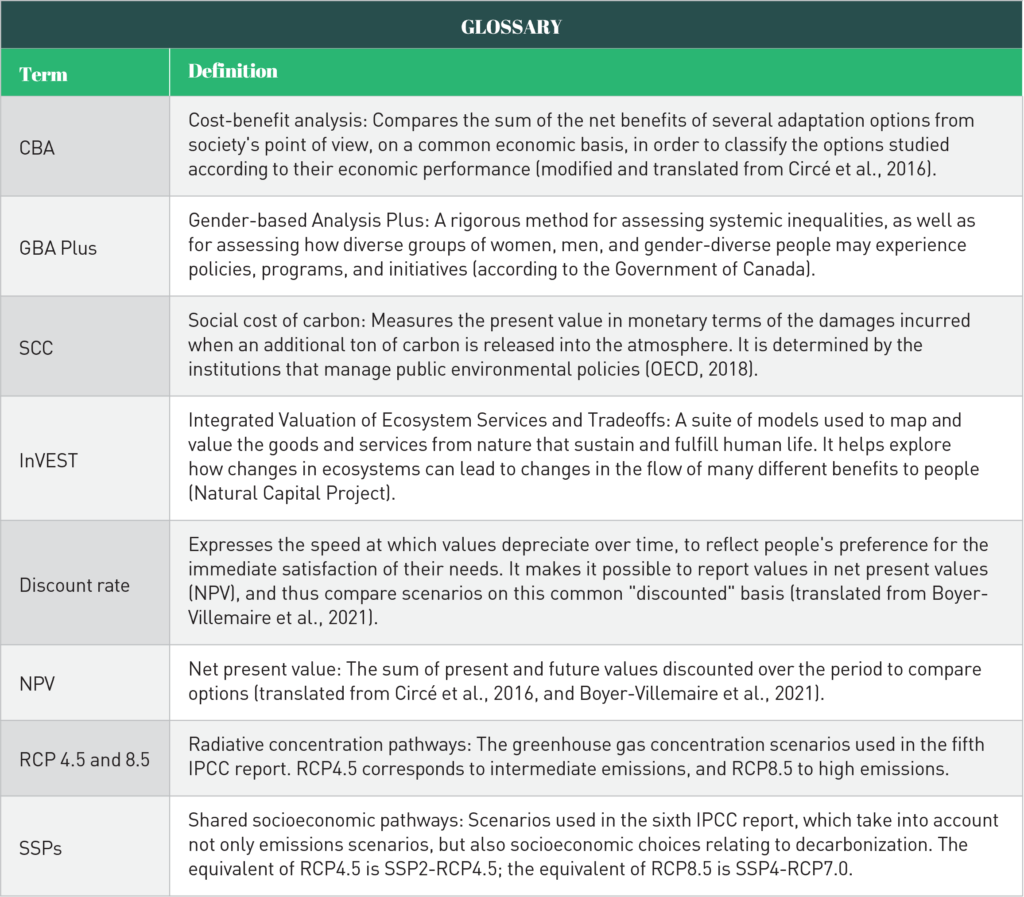
Extend the Timeframe for Decisions: Study Period, Long-term Living Conditions, Decreasing Discount Rate
The likelihood of climatic hazards is increasing, and a continuous risk assessment (identification, analysis, and evaluation) is becoming a necessity. In addition to historical hazards, future and emerging risks (typically over a few decades) are better integrated into long-term planning. So, in the case of Percé, a 50-year decision-making period was selected, and the period was divided into three time horizons, in which the climate was considered stable.
In addition, the IPCC calls for the enhancement of minimum and dignified living conditions (“development first”) to be placed at the heart of resilient development trajectories. This includes preserving environmental integrity and redefining the bases of profitability. In the case of Percé, these values were expressed by the various stakeholders, integrated into the adaptation scenarios, and then into the impacts considered in the decision-making process.
Finally, NPV has been used in CBA as an economic indicator of the balance between costs and benefits. The discount rate is applied as a corrective to reflect individuals’ preference for the present time; however, this preference exacerbates inequalities between generations. Thus, in the Percé study, a low discount rate of 4 % was used, compared to the 6–8 % recommended for public policy. Since the Percé case, practices have evolved, and international guides (e.g. OECD, 2018) favour low and decreasing rates over time (see Boyer-Villemaire et al., 2016).
Integrating Climate Risks
Climate information develops climatic scenarios affecting the likelihood of climatic hazards. The Ouranos Climate Portraits1 portal supports the prior identification of hazards, which are then refined and applied to the geographical area at issue. It remains a good practice to assess the effect of climate models and scenario choices on decision-making (Charron, 2016), and the sixth IPCC report published new global climate simulations (the CMIP6 ensemble) and global scenarios (SSPs).
At Percé, two emissions scenarios were used for the economic evaluation (RCP4.5 and RCP8.5) to test the sensitivity of the decision.
Once climate scenarios and variables are determined, the climate impact chains are integrated into the systems using risk assessment standards (ISO14090, -91, -92) and operational tools (CVIIP, BARC from ICLEI, VACCIn). These impact chains are characterized by the following:
- Levels of impact (direct, indirect, and systemic)
- Degree of integration: a diversity of exposed elements (specific vulnerability of assets and activities), but also of impacts on the environment and on the health and safety of populations
In Percé, the risk analysis was based on a modelling approach using expert contracts. The consequences of the erosion hazard were considered both directly (e.g. loss of land) and indirectly (e.g. loss of visitors). As submergence was not an issue, only sea-level rise was considered in the design of solutions. In addition, indicators from the three pillars of sustainable development were used for the integrated impact assessment (see next section).
Choosing Solutions to Take Greater Complexity Into Account
With a range of parameters evolving in time and space, complexity lies at the heart of climate adaptation decisions. This affects the reference scenario, the integrated impact chains, the handling of uncertainties, and the need for complementary analyses.
The choice of reference scenario is between the status quo (current practices) and non-intervention. In the Percé study, the non-intervention scenario was used, reflecting an openness to revisiting previous choices.
In climate adaptation, the diversity of impacts—over and above financial impacts—is central and includes the following:
- Maximized avoided costs: The chosen solution is effective in reducing damage (60–70 % of the status quo; Boyer-Villemaire et al., 2021), at an affordable total cost.
- Quantifying environmental goods and services: The optimal decision implies no effects, or even marked benefits, for the environment (assessed by using, among others, Markandaya’s classification of environmental services (OECD, 2018)).
- The social cost of carbon (SCC): The optimal solution will mitigate the flow of carbon and be effective at reducing risk. The value of SCC is determined by Environment and Climate Change Canada at C$50/tonne of CO2 (ECCC, 2016) (research now suggests $290/tonne of CO2 (Rennert et al., 2022)).
- Quantifying impacts on health: Analysis of additional healthcare expenditures (lost productivity, loss of quality of life, and additional costs).
- Emergency management costs: The reduction in emergency management costs differentiates certain solutions that significantly reduce exposed assets.
In Percé, the chosen solution avoided 100 % of the damage. The environmental impacts of the solutions were considered by transferring benefits according to encroachment and compensation costs, but carbon was not considered. On the health side, the impact considered the loss of access to a beneficial location (daily walking), and was estimated by the additional travel time to an alternative location. The costs of emergency management were not considered.
Finally, additional analyses were necessary to assess the robustness of the decision. In Percé, quantitative sensitivity analyses (discount rate, climate modelling, hazards) were carried out, but more recently, an a posteriori multicriteria approach is being recommended to integrate more uncertainties into the decision, such as consideration of intangibles and social aspects (e.g. GBA Plus method), residual risks, and others (Boyer-Villemaire et al., 2016).
Percé CBA Results
According to the NPV of the segment at the centre of Percé (Figure 3), non-intervention would generate losses of $700 million; hazard control solutions (concrete wall, riprap) would lead to losses of $300 to $400 million; and, two clearly advantageous solutions (beach nourishment and nourishment with groynes) make it possible to maintain tourist traffic at low realization costs.
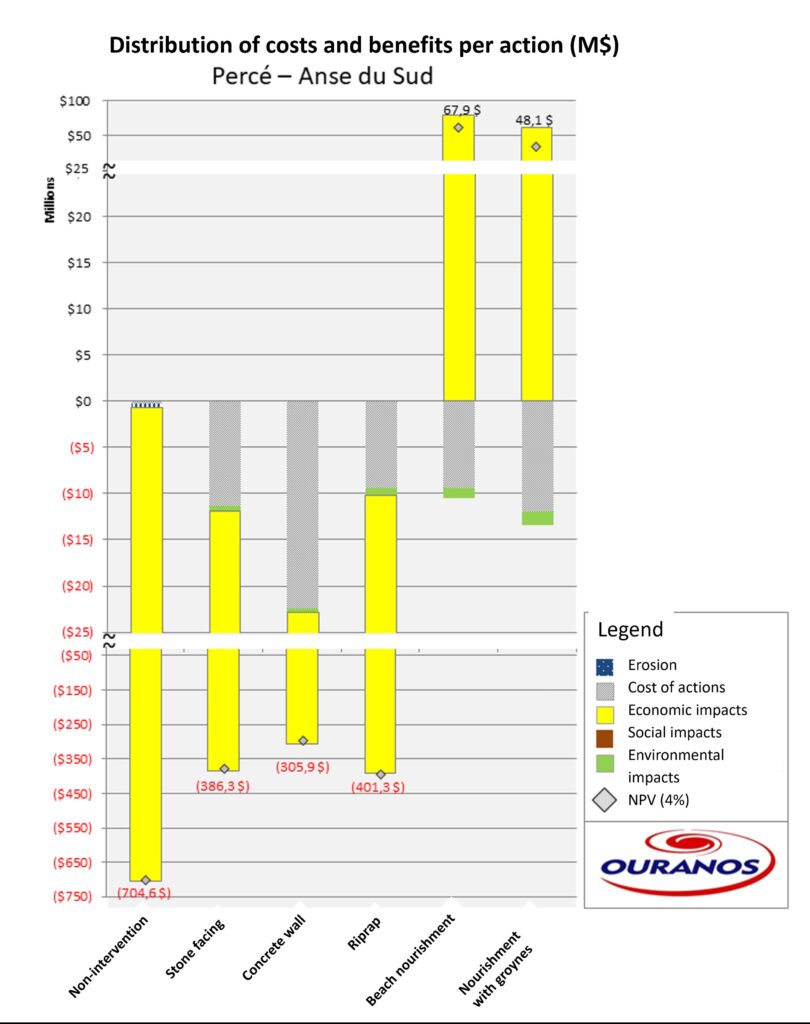
Lessons and Recommendations
The Benefits of This Approach
The Coastal Zone CBA project not only supported the Municipality of Percé and other regional players in the improved management of coastal developments and assets, but also convinced the Quebec government to take action. Indeed, the benefits of this series of cost-benefit analyses are still materializing today (Table 2).
- First level: Collective justification for investing locally.
- Second level: Transfer of this CBA approach, based on coastal risks, to other territories or other climatic hazards.
- Third level: Transformation of coastal zone institutions and governance, the ultimate level of collective learning for society.
Finally, it should be noted that the follow-up of the outcomes has been carried out through sporadic contacts. This would benefit from being more structured.
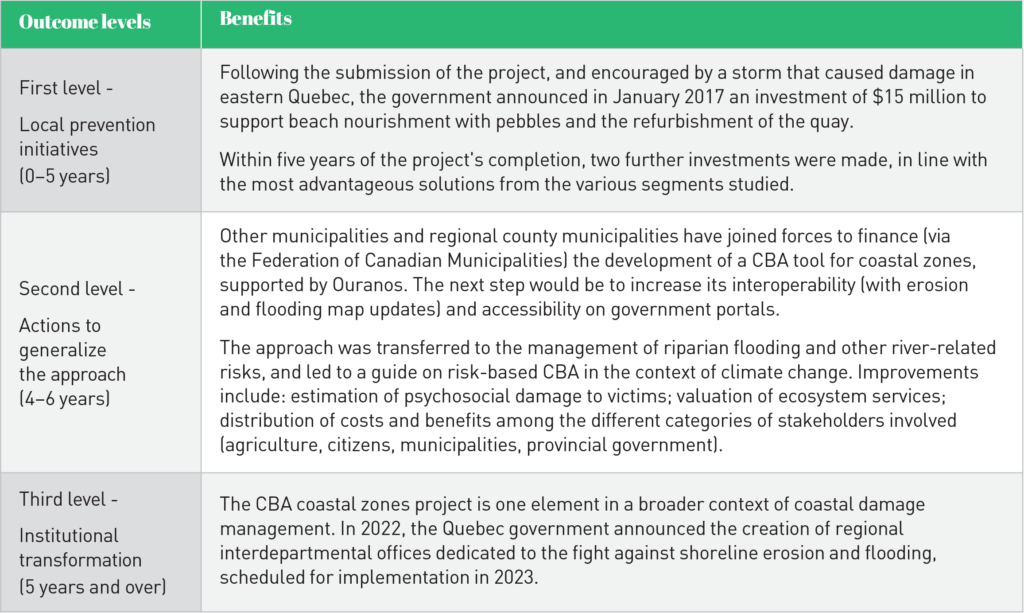
Multidisciplinary Dialogue for Robust Decisions
Bringing together a wide range of disciplinary knowledge and skills (climate and environmental sciences, disaster risk management, economics, and management) has certainly strengthened the approach. However, it is essential to plan for a multidisciplinary project coordination role.
The climate change adaptation approach also reveals the importance of agreements to make decisions in a context of growing uncertainty (modelling, climate, socioeconomic evolution). To take robust account of uncertainty without hampering decision-making, we need to do the following:
- Adopt a participatory framework that engages stakeholders in dialogue to build consensus on the notions of acceptable risk, intergenerational equity, environ-mental integrity, and reconsideration of past choices.
- Integrate climate change by analyzing the many uncertainties (Charron, 2016) and providing for updates.
The climate crisis and the biodiversity crisis are interrelated. It is therefore important to integrate environmental benefits into decision-making, environmental impact assessments, and potential adaptations based on nature, like natural or hybrid infrastructure.
Need to Accelerate Risk-based Decision-making and Support
Finally, as food for thought, it is clear that the various players involved in adaptation want first and foremost to find solutions, which would require a better operationalization of the conceptual framework of risk resulting from the sixth IPCC report. There is also a need for accessible tools and support to generalize and accelerate decision-making based on climate risks, in both public and private organizations. These tools and methods may exist at the boundary between research and society but these questions remain: what operational, accessible, and effective tools can science offer, and what support can organizations receive to help them make the shift to integrating climate risks into their decision-making?




